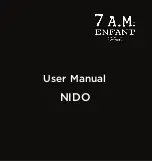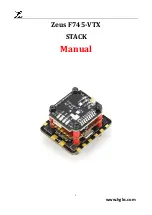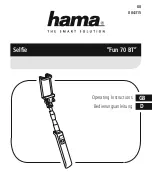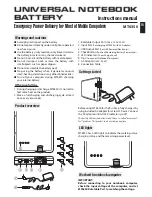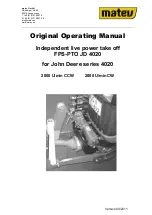
4
[Startup and Maintenance Precautions]
PRECAUTIONS FOR USE
Observe the following precautions when installing and operating the vision sensor, to avoid the risk of injury or equipment
damage:
• The power for a vision sensor is intended to be supplied by UL or NRTL approved power supply with a lowest rated output
voltage of 24 V DC with at least 2 A of current, a maximum short circuit current rating of less than 8 A, a maximum power
rating of less than 100 VA, and marked Class 2 or LPS (Limited Power Source).
Any other voltage creates a risk of fire or shock and can damage the components.
Applicable national and local wiring standards and rules must be followed.
• To reduce the risk of damage or malfunction due to over-voltage, line noise, electrostatic discharge (ESD), power surges, or
other irregularities in the power supply, route all cables away from high-voltage power sources.
• Do not install the vision sensor where they are directly exposed to environmental hazards such as excessive heat, dust,
moisture, humidity, impact, vibration, corrosive substances, flammable substances, or static electricity.
• Do not expose an image sensor to laser light; image sensors can be damaged by direct or reflected laser light.
If your application requires the use of laser light that may strike the image sensor, a lens filter at the corresponding laser's
wavelength is recommended.
Consult your local system integrator or application engineer for suggestions.
• A vision sensor does not contain user-serviceable parts. Do not make electrical or mechanical modifications to a vision
sensor.
Any modification may void your warranty.
• Changes or modifications not expressly approved by the party responsible for regulatory compliance could void the user’s
authority to operate the equipment.
• Service loops (extra wire length) should be included with all cable connections.
• If the bend radius or service loop is smaller than 10 times of the cable diameter, the cable may cause cable shielding
degradation, cable damage, or wear out in a short period.
The bend radius must begin at least 152.4 mm from the connector.
• This equipment is a Class A device. Using this equipment in a domestic environment may cause radio disturbance. In this
case, the user may be required to take appropriate measures.
• If there is concern about noise, set a noise filter (SNR-10-223, COSEL or an equivalent) between the vision sensor and the
stabilized DC power supply.
• To maintain the safety of the system against unauthorized access from external devices via the network, take appropriate
measures.
To maintain the safety of the system against unauthorized access from external devices via the Internet, take measures
such as installing a firewall.
CAUTION
●
Do not clean the vision sensor with highly irritating or corrosive solvent such as caustic alkali solution,
methyl ethyl ketone (MEK), and gasoline. Doing so may cause a fault.
Summary of Contents for MELSENSOR VS70 Series
Page 2: ......
Page 14: ...12 1 PRODUCT OVERVIEW MEMO ...
Page 16: ...14 2 PART NAMES MEMO ...
Page 96: ...94 7 INSTALLATION 7 2 Registration of a Profile MEMO ...
Page 98: ...96 8 MAINTENANCE AND INSPECTION 8 2 Clean an Image Sensor Window MEMO ...
Page 100: ...98 9 TROUBLESHOOTING MEMO ...
Page 111: ......
























